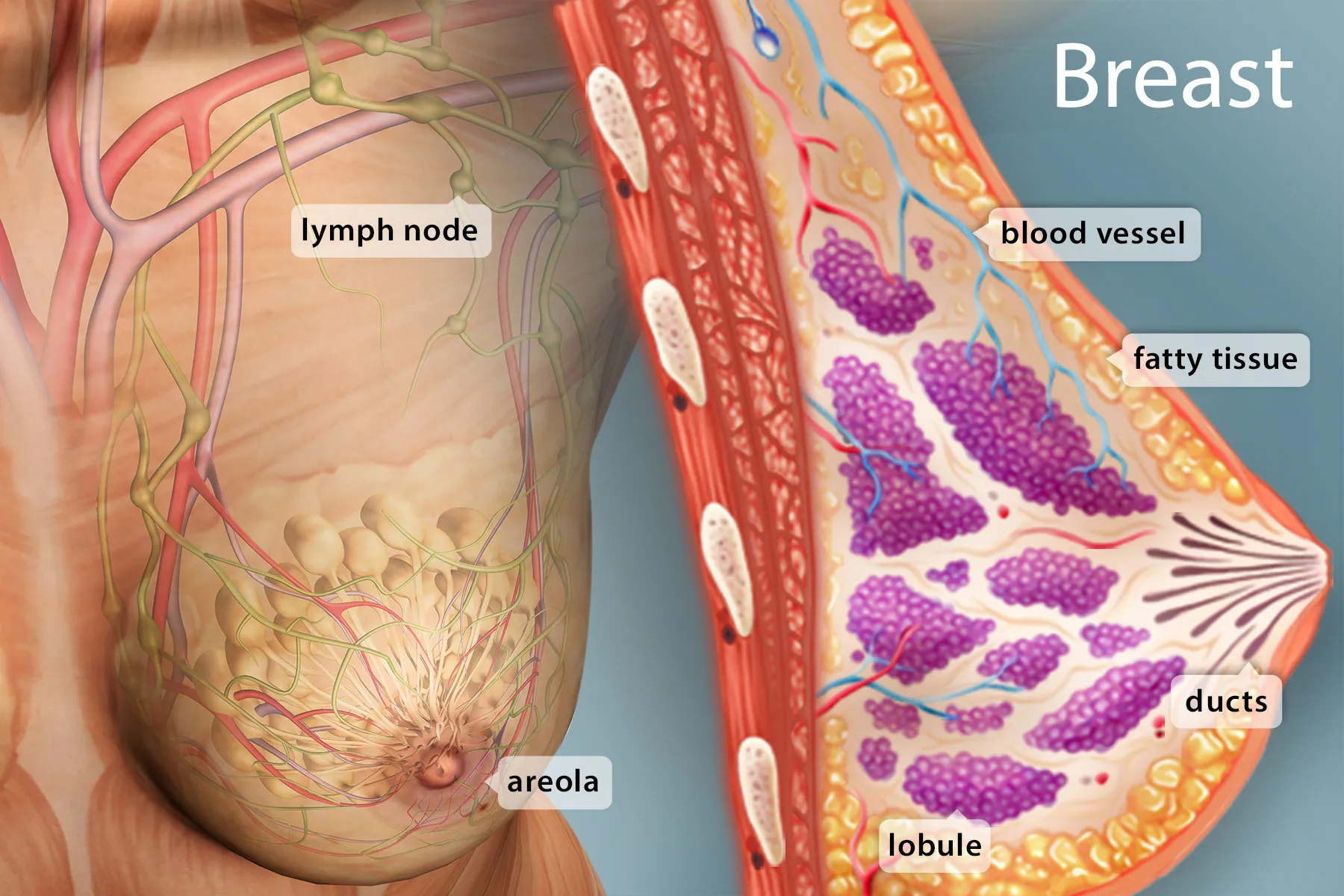"Normal Breasts:" What Does This Mean?
There's no such thing as the perfect or perfectly normal breast. They come in all shapes and sizes. Even on the same person, one breast can be a different size or shape than the other.
Nipples and the surrounding skin, called the areola, vary in size, shape, and color as well. Nipples can stick out, lay flat, or point inward. Areolas can be light pink, brownish-black, or any shade in between. You might or might not have hairs around your nipples and stretch marks on your breasts.
And, what's "normal" for you can change over a lifetime.
Your breasts go through changes when you have your period, when you’re pregnant or breastfeeding, and when you go through puberty and its flip side, menopause. They change when you gain or lose weight. They change in response to birth control pills and hormone replacement therapy. If you are a transgender woman and take hormone treatments, you will have breast changes.
It's a good idea, though, to get to know your breasts and pay attention when they change -- so you can know when to relax and when it might be worth a call to the doctor.
Breast Anatomy
Everyone is born with some breast tissue. During puberty, those assigned female at birth typically develop more breast tissue.
Each fully developed breast has 15 to 20 sections, or lobes, that surround the nipple like spokes on a wheel. Inside these lobes are smaller lobes called lobules. At the end of each lobule are tiny "bulbs" that make milk. These are linked together by small tubes called ducts, which carry milk to the nipples.
The nipple is in the center of a darker area of skin called the areola. The areola contains small glands called Montgomery glands, which lubricate the nipple during breastfeeding. Fat fills the spaces between the lobes and ducts.

There are no muscles in the breasts, but the pectoral or chest muscles lie under each breast and cover the ribs.
Each breast also contains blood vessels, as well as vessels that carry a fluid called lymph. Lymph travels throughout the body through a network called the lymphatic system. The lymphatic system carries cells that help the body fight infections. The lymph vessels lead to the lymph nodes (small bean-shaped glands).
Breast development and function depend on the hormones estrogen and progesterone, which are made in the ovaries. Estrogen elongates the ducts and makes them create side branches. Progesterone increases the number and size of the lobules in order to prepare the breast for feeding a baby.
In people who have periods, progesterone makes the breast cells grow and blood vessels enlarge and fill with blood after ovulation each month. At this time, the breasts often become engorged with fluid and may be tender and swollen.
Different Breast Shapes
Healthy breasts come in lots of shapes. If you're not sure how you would describe yours, plastic surgeons and bra makers have some terms that might help. They often describe breast shapes as:
- Round or archetype breasts, which are evenly full on the top and bottom
- Teardrop breasts, which are fuller on the bottom than the top
- Asymmetrical breasts, which are uneven in size or shape
- Wide-set breasts, which sit far apart from each other on the chest
- Close-set breasts, which are close together on the chest
- Tubular or conical breasts, which are narrow, long, and less rounded
- Relaxed or sagging breasts, which may appear to droop, often after pregnancy or as a result of weight loss or age
When you know your breasts well, it's easier to notice when something changes. Most changes aren't signs of breast cancer or other serious health problems, but some do warrant a check with your doctor. Here’s what to know about breast issues that you may notice.
Breast Lumps
Try not to worry. Most lumps are not cancer. Cysts and other harmless causes are more common. And most cancers don't start with a noticeable lump. But do see your doctor to find out what it is. This is especially important if you notice large lumps in your armpit or if the bumpy area doesn’t go away after 6 weeks.
Your doctor will check your breasts and probably recommend a mammogram and possibly other tests. They may use a needle to remove some fluid from the area or take a small sample of the lump for more testing.
Don't wait for your next scheduled mammogram to check out a lump, no matter how recently you had your last one. Breast cancers can develop between mammograms.
Men and others assigned male at birth don't usually get mammograms, but they can get breast cancer. So, they should also see a doctor about any breast lumps. The most common cause of a breast lump in men is a noncancerous condition called gynecomastia.
Breast Color and Texture Changes
If the skin around your breasts becomes dimpled, itchy, scaly, or red, you should see your doctor. They may just keep an eye on this or order a biopsy -- removing a small piece of tissue -- to make sure everything is OK.
Breast Rash
You could have redness or irritation on your breast, or a rash that's itchy, painful, scaly, or blistered. If you see or feel any of these things, you should see your doctor.
You could have something that's also common in other parts of your body, including:
- Eczema
- Candidiasis (a fungal infection caused by yeast)
- Cellulitis (a bacterial skin infection)
- Hives
- Psoriasis
- Scabies
- Seborrheic dermatitis (a skin condition)
- Shingles
There are some rashes that you'd get only on your breast. Causes for these include:
- An abscess
- Mammary duct ectasia (when milk ducts beneath your nipple get wider)
- Mastitis (a breast tissue infection usually tied to breastfeeding)
- Nipple eczema (dermatitis)
A rash on your nipple can also be a sign of a couple of different types of breast cancer. One rare form, Paget's disease of the breast, starts on the nipple and spreads to the skin around it (which your doctor may call your areola). The other, inflammatory breast cancer, makes your breast red, swollen, and tender. It happens when cancer cells block lymphatic vessels in your breast skin.
Nipple Discharge
This includes any fluid that comes out of your nipple. It can happen during pregnancy and breastfeeding. It can even continue up to 2 years after you stop nursing. This is all normal.
The hormonal changes associated with menopause can also cause some leakage. Transgender women who use hormone therapy can have nipple leakage too. But others assigned male at birth should talk to their doctor about any nipple discharge.
Anyone who has nipple discharge should see their doctor if the discharge is:
- Bloody
- Coming from just one breast
- Happening without touching or squeezing the breast
- Accompanied with breast pain, redness, swelling, or nipple changes.
The cause could be an infection, a sac filled with fluid called a cyst, other lumps that aren’t cancer (such as fibroadenomas), or cancer.
Your doctor will give you a checkup, including a physical exam of both breasts. They’ll ask about your symptoms and family medical history. You may also get a mammogram or sonogram to check inside the breasts.
Nipple Pain
Your nipples are sensitive, and they can hurt for lots of reasons, from clothes that fit poorly to more serious reasons.
Skin conditions such as dermatitis, contact dermatitis, and eczema can cause pain in your nipples. Pregnancy or breastfeeding can do it, too. For some, nipples that hurt can be a sign that a period is coming. Infections such as mastitis and thrush can also aggravate the nipples.
Sore nipples may make you worry about breast cancer. But while it can be a sign of breast cancer, nipple pain is hardly ever the main symptom.
Nipple Changes
Every once in a while, you might see something different with your nipples.
If you notice hair on them, don't worry. That dark circle around your nipple, the areola, has hair follicles. If it bothers you, you can cut any hair there with some small scissors.
Some people are born with inverted nipples, but others develop them later in life. Your doctor may call them retracted. This can be a normal part of aging, can happen when you’re breastfeeding, or may happen after you've had surgery on your breast. It can be a result of a breast injury as well.
If your nipples are newly inverted, you should see your doctor. They could be a sign of mastitis, mammary duct ectasia, or an abscess under your areola.
If it happens suddenly to one or both nipples, nipple inversion could be a sign of breast cancer.
Soreness and Tenderness in Breasts
If you have periods, that's always a possible cause of soreness in your breasts. The breast soreness can start before or after your bleeding starts. This is normal, and usually, the pain goes away on its own. But get the pain checked out if it gets worse, if it’s in one area of your chest, or if it affects your daily routine (such as working out or lifting your kids).
Things that can cause breast pain include birth control pills, hormone treatments, or having large breasts. During your exam, your doctor may consider whether it might help to change any hormonal medications. For some types of breast pain, it may help to cut down on caffeine.
A better bra can sometimes help people with large breasts feel more comfortable. In some cases, breast reduction surgery can make sense.
Armpit Pain
If you're feeling pain in your armpit and aren't sure where it comes from, you should see your doctor.
While it could be something as simple as a muscle strain or swollen lymph nodes caused by a viral infection, it could also be a sign of breast cancer.
You might have no symptoms of cancer in your breast. But underarm pain and swelling could mean that cancer has spread from your breast into your lymph nodes.
Changes in Breast Size or Shape
Your breasts may change at different points in your life. For instance, your breasts might get bigger when you have your period or when you’re pregnant, due to hormones.
After menopause, you may feel like your chest sags, becoming smaller and losing its shape. This is common.
But if you notice changes at other times -- if your breasts look or feel different -- check with your doctor to make sure everything is OK.
When to Worry About Breast Pain
Temporary breast pain from your period or other causes you can easily explain (such as a new, badly-fitting bra) are clearly no cause for concern. But, in other cases, you might need a doctor's help to figure out what's going on. Keep in mind that pain is not usually a sign of breast cancer.
Check with your doctor if one or both of your breasts hurt and any of these things is true:
- The breast suddenly gets swollen, red, or heavy
- The skin on the breast thickens and dimples
- You have breast implants -- which can rupture and cause scarring
- You have bloody or clear nipple discharge
- You've just given birth and your breasts are swollen and hard
- You have a lump that doesn't go away after your next period
- You have possible signs of infection, such as redness, pus discharge, or fever
- The pain is lasting and unexplained
Takeaways
Breasts come in a variety of shapes and sizes. They change over your lifespan. Most changes, even lumps and pain, aren't signs of serious health problems. But getting to know your breasts and working with your doctor when something seems new or amiss can save you a lot of worry and help you find problems early when they do arise.

